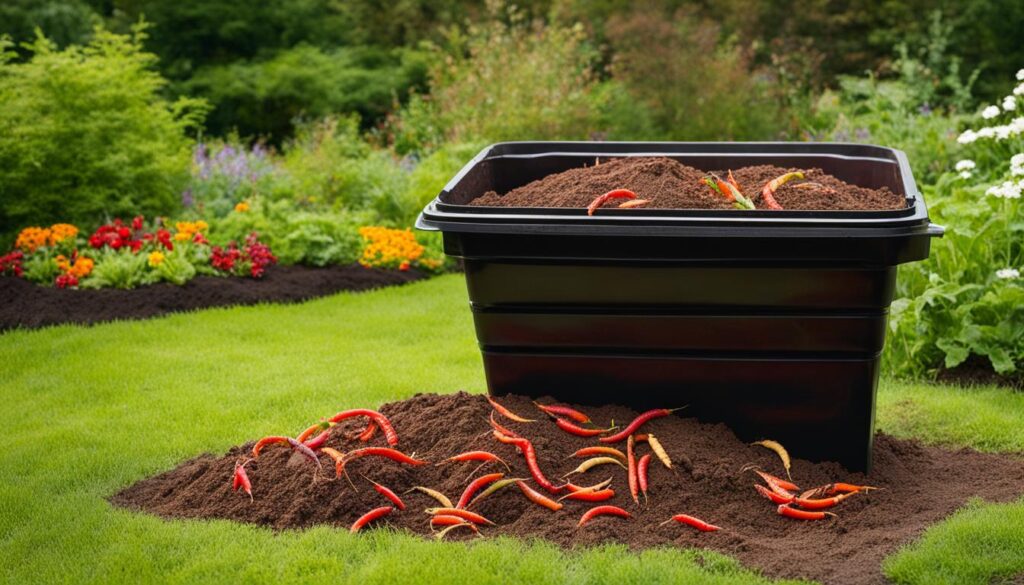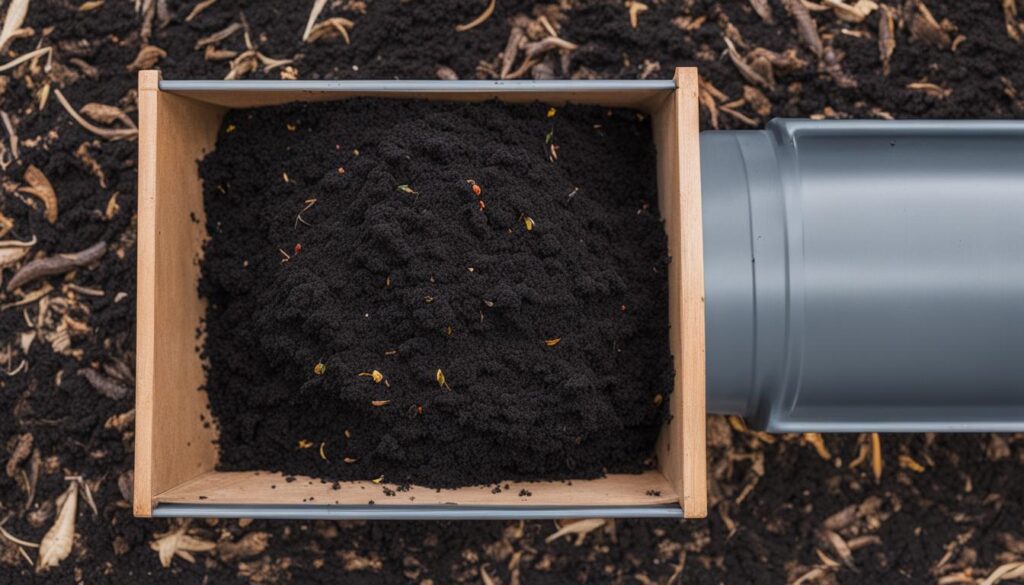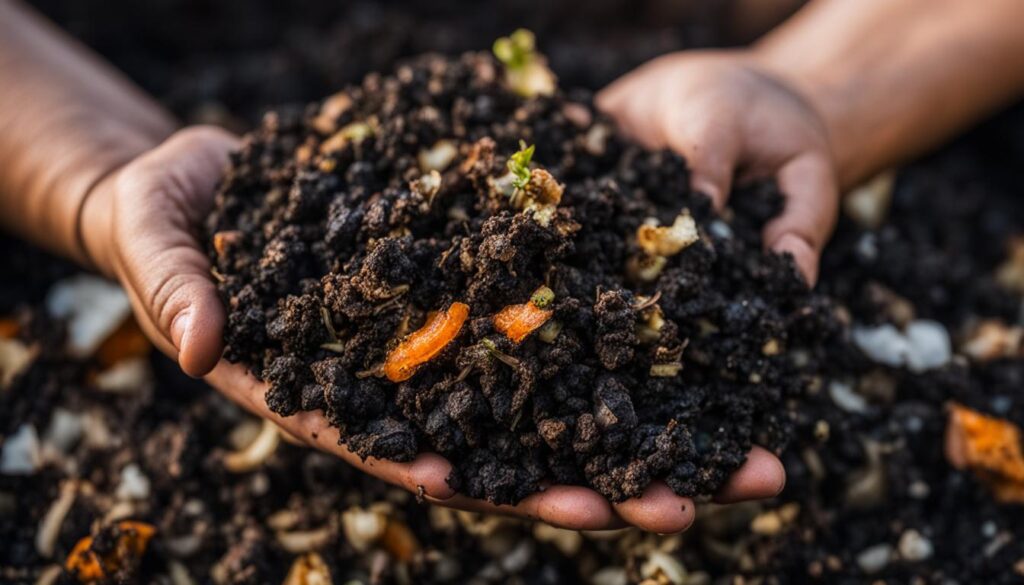Worm bin vs composting are both popular methods for organic waste decomposition and fertilizer production. While they have similarities, such as breaking down organic waste into fertilizer, there are key differences in setup, convenience, speed, volume, pathogens, aeration, and cost. Understanding these differences will help you choose the method that best fits your needs and lifestyle.
Key Takeaways:
- Worm bin and composting are effective methods for organic waste decomposition and fertilizer production.
- Worm bins offer the benefits of compact size, minimal odor, and versatility for indoor or outdoor use.
- Composting requires larger space and regular turning for proper aeration and decomposition.
- Vermicomposting with a worm bin is faster, while composting can handle larger volumes of organic material.
- Hot composting kills pathogens, while vermicomposting does not. Proper maintenance is crucial for reducing pathogen growth.
Setup and Process: Worm Bin
Starting a worm bin is a simple and rewarding process. Here’s a step-by-step guide on how to start your own worm bin:
- Choose a suitable bin: Select an enclosed bin such as a tray-based composter or a DIY tote bin. Ensure that it has a lid to keep the worms safe and help maintain moisture levels.
- Create bedding: Prepare a bedding for the worms by combining materials like coconut coir, shredded newspaper, or peat moss. The bedding should be moist but not dripping wet.
- Add worms: Purchase red wigglers or redworms, which are commonly used for vermicomposting. Start with a population of about 1 pound (approximately 1000 worms) for a regular-sized bin.
- Feed the worms: Begin by adding small amounts of kitchen scraps, vegetable peels, and fruit scraps to the bin. Avoid adding meat, dairy, oily foods, or citrus as they can attract pests or harm the worms.
- Maintain the bin: Regularly monitor the moisture levels in the bin and adjust as needed. Keep the bin in a cool, shaded area to prevent the worms from overheating.
- Harvest the compost: After a few months, the food scraps will be transformed into nutrient-rich compost called “humus.” Scoop out the compost from the bin, being careful not to disturb the worms, and use it in your garden or potted plants.
Starting a worm bin allows you to engage in vermiculture, a process that takes advantage of worms’ natural tendencies to break down organic waste into valuable compost. It’s an efficient and sustainable method that can be done in small spaces, making it ideal for urban dwellers or those with limited outdoor areas.
Vermicomposting
Vermicomposting is a type of composting that uses worms to break down organic waste. Unlike traditional composting, which relies on microorganisms for decomposition, vermicomposting harnesses the digestive power of worms to accelerate the process.
Worms are voracious eaters and can consume a significant amount of organic waste. As they feed on the food scraps, they excrete nutrient-rich castings, which are highly beneficial for plant growth. Vermicomposting not only helps reduce waste but also produces a valuable resource that can enhance the health and fertility of your soil.
Whether you have a small apartment or a large backyard, starting a worm bin is an accessible and eco-friendly way to manage your food waste and contribute to a more sustainable lifestyle.

Setup and Process: Composting
Composting is a popular method for organic waste decomposition and can be done in a bin or a pile. To start composting, you will need a designated container or an outdoor area for the pile. The setup is relatively simple and involves adding organic waste such as kitchen scraps, yard waste, and shredded paper to the bin or pile. It’s important to mix the materials well for optimal decomposition and to maintain a good balance of carbon-rich materials (like dried leaves) and nitrogen-rich materials (like fresh vegetable scraps).
There are various composting methods to choose from. Hot composting involves regularly turning the pile to introduce oxygen and speed up the decomposition process. This method requires a larger volume of organic waste and can produce usable compost within a few months. Cold composting, on the other hand, is a slower process that doesn’t require frequent turning. It is ideal for those who have limited time and a smaller amount of organic waste to compost. Compost tumblers are also available, which provide a controlled environment for composting, allowing for easier turning and faster decomposition.
Remember to monitor the moisture levels in the compost bin or pile to ensure proper decomposition. The material should be damp, like a wrung-out sponge, but not overly wet. If it becomes too dry, you can add water; if it becomes too wet, you can add dry materials like shredded newspaper or leaves to absorb excess moisture. Following these guidelines will help you create nutrient-rich compost that can be used in your garden to enrich the soil and promote healthy plant growth.
| Composting Method | Pros | Cons |
|---|---|---|
| Hot Composting | Fast decomposition Kills pathogens Large volume capacity | Requires regular turning Requires larger space Can produce odors if not managed properly |
| Cold Composting | Less maintenance Smaller space requirement Suitable for smaller amounts of organic waste | Slower decomposition No pathogen-killing temperatures May attract pests if not managed properly |
| Compost Tumblers | Easier turning Faster decomposition Controlled environment | Can be more expensive Limited capacity Requires regular monitoring |
Convenience: Worm Bin vs Composting
When it comes to convenience, both worm bin and composting methods have their own advantages and considerations. Let’s take a closer look at the convenience factors of each method.
Worm Bin Convenience
One of the notable conveniences of worm bin composting is its versatility in terms of location. Whether you live in an apartment or have limited outdoor space, you can easily set up a worm bin indoors or outdoors. This makes it an ideal option for urban dwellers or those with limited gardening space.
In addition to its adaptability, a well-maintained worm bin typically produces minimal odor. This is beneficial for households concerned about unpleasant smells. Another advantage of worm bins is their mobility. During colder months, you can easily move the worm bin indoors to protect the worms from extreme temperatures, ensuring their well-being all year round.
Composting Convenience
While composting also offers convenience, it is typically done outdoors and requires a larger space compared to a worm bin. This means you will need to allocate an area in your yard or garden for composting. However, once you have set up a composting system, it requires less maintenance compared to a worm bin.
While composting may produce odors if not managed properly, regular turning and proper moisture control can significantly reduce this issue. It’s worth noting that composting systems may require a bit more effort in terms of manual turning to introduce air and promote effective decomposition.
Overall, both worm bin and composting methods have their own conveniences depending on your specific circumstances and preferences. Consider factors such as available space, mobility, odor concerns, and the level of effort you are willing to invest in maintenance to determine which method is more convenient for you.

Comparing Convenience
| Worm Bin | Composting | |
|---|---|---|
| Location | Can be done indoors or outdoors | Takes up outdoor space |
| Odor | Minimal odor when properly maintained | Possible odor if not managed properly |
| Mobility | Can be moved indoors during winter | Stationary outdoor system |
| Maintenance | Regular monitoring and feeding | Requires less maintenance once set up |
Speed and Volume: Worm Bin vs Composting
When it comes to speed and volume, both worm bin and composting methods have their own advantages and limitations. Let’s take a closer look at how they differ in terms of decomposition speed and the amount of organic waste they can handle.
Decomposition Speed
The speed of decomposition is an important factor to consider when choosing between a worm bin and composting. Vermicomposting with a worm bin is typically faster compared to traditional composting methods. Worms are efficient decomposers and can break down organic waste into usable compost in as little as 2-3 months. On the other hand, composting through hot composting techniques may take anywhere from 6-9 months to produce usable compost. The slower decomposition rate of composting is mainly due to the absence of worms, which play a key role in speeding up the breakdown process in a worm bin.
Volume Handling
While worm bins are efficient in terms of speed, they have limitations when it comes to volume handling. Worm bins are generally smaller in size and have restrictions on the depth and capacity they can handle. Composting, on the other hand, can handle larger amounts of organic material since it is not constrained by the size of the worm bin. If you have a large volume of organic waste to process, composting may be a more suitable option. However, it’s important to note that overloading a compost pile can lead to slower decomposition rates and potential odor issues.
| Worm Bin | Composting | |
|---|---|---|
| Decomposition Speed | Faster (2-3 months) | Slower (6-9 months) |
| Volume Handling | Restricted by size | Can handle larger amounts |
Ultimately, the choice between a worm bin and composting method depends on your specific needs and preferences. If you have a smaller space and a relatively smaller volume of organic waste, a worm bin can provide a faster and more efficient decomposition process. However, if you have a larger volume of organic waste and ample space, composting may be a better option to handle higher volumes. Consider the time you have available, the amount of organic waste you generate, and the space you have when deciding which method suits your needs.
Pathogens and Aeration: Worm Bin vs Composting
When it comes to dealing with pathogens, there are notable differences between worm bin composting and traditional composting. Worm bins, also known as vermicomposting systems, tend to run cooler and do not reach the high temperatures that are capable of killing pathogens. This means that if you are concerned about the presence of pathogens in your compost, traditional composting methods that involve hot composting may be a better option for you.
Hot composting, on the other hand, reaches higher temperatures that can effectively kill pathogens, making it a safer choice if you want to minimize the risk of pathogen growth. Regular turning of the compost pile is necessary to introduce air and maintain the aerobic conditions required for the decomposition process. Aeration is crucial in composting as it helps promote the growth of beneficial microorganisms that aid in the breakdown of organic matter.
Worm bins, however, have a natural means of aeration. As worms tunnel through the organic waste in the bin, they create passageways that allow for the exchange of gases, maintaining a well-aerated environment for the decomposition process. This eliminates the need for regular turning, making worm bin composting a more low-maintenance option in terms of aeration.
| Pathogens | Aeration | |
|---|---|---|
| Worm Bin | Does not reach temperatures to kill pathogens | Naturally aerated by worms’ tunneling |
| Composting | Hot composting can kill pathogens | Requires manual turning for aeration |
Understanding the differences in pathogens and aeration between worm bin composting and traditional composting methods can help you make an informed decision based on your specific needs and concerns. If you prioritize pathogen control, hot composting may be the better choice. However, if you prefer a low-maintenance approach to aeration, worm bin composting offers a more hands-off solution.

Quotes:
“Hot composting can be an effective method for reducing pathogens in compost, making it a safer option if you plan to use the compost in your garden.”
“Worm bins, while not capable of killing pathogens, provide a natural means of aeration through the worms’ tunneling, which can help maintain a healthy decomposition process.”
Conclusion
Both the worm bin and composting methods offer valuable benefits for organic waste management and fertilizer production. Worm castings, the concentrated form of worm excrement, are a nutrient-rich source filled with beneficial microorganisms. On the other hand, compost provides organic matter and serves as a versatile bulk fertilizer.
Combining compost and worm castings can create a holistic approach to enriching soil. This combination enhances soil structure, provides essential nutrients, and promotes the health of microbial life. By utilizing both methods, you can maximize the benefits for your garden or plants.
When making a decision between a worm bin and composting, it’s crucial to consider your available space, convenience, and personal preferences. Worm bins are suitable for both indoor and outdoor use, making them ideal for apartment dwellers or homeowners. Composting, however, is typically performed outdoors and requires a larger area. Keep in mind the regular turning and proper maintenance necessary for effective composting.
Ultimately, by understanding the differences and advantages of each method, you can choose the one that best fits your needs and lifestyle. Whether you opt for the nutrient-rich worm castings or the versatile compost, both methods contribute to a sustainable and thriving garden.
FAQ
What is the difference between a worm bin and composting?
Worm bin and composting are both methods of organic waste decomposition and fertilizer production, but there are differences in setup, convenience, speed, volume, pathogens, aeration, and cost.
How do I start a worm bin?
To start a worm bin, you need an enclosed bin, bedding materials like coconut coir or shredded newspaper, and worms like red wigglers. The worms eat the food scraps and produce nutrient-rich compost through vermicomposting.
How do I start composting?
Composting can be done in a bin or pile. You add organic waste like kitchen scraps and yard waste and allow it to break down through an aerobic process. Turning the compost and maintaining proper moisture levels are important.
Can I do worm bin composting indoors?
Yes, worm bin composting can be done both indoors and outdoors, making it convenient for apartment dwellers or homeowners. It has minimal odor and can be moved indoors during the winter.
Can I compost indoors?
Composting is most commonly done outdoors and requires a larger space. It requires regular turning and may produce odors if not managed properly.
Which method is faster, worm bin or composting?
Worm bin composting is typically faster than traditional composting. Worms can produce usable compost in 2-3 months, while hot composting may take 6-9 months.
How much organic material can each method handle?
Composting can handle larger amounts of organic material, while worm bins have limits on depth and capacity.
Do worm bins kill pathogens?
Vermicomposting with a worm bin runs cooler and does not kill pathogens. Proper maintenance can help reduce pathogen growth.
Does composting kill pathogens?
Hot composting reaches higher temperatures that can kill pathogens. Following guidelines for composting can help reduce pathogen growth.
How do the methods handle aeration?
Composting requires manual turning to introduce air, while worm bins are naturally aerated by worms’ tunneling and do not need regular turning.
What are the benefits of worm castings and compost?
Worm castings are rich in nutrients and beneficial microorganisms, while compost provides organic matter and a versatile bulk fertilizer. Combining them can enhance soil structure, provide nutrients, and promote microbial health.
Source Links
